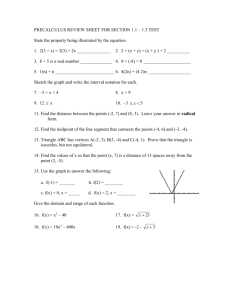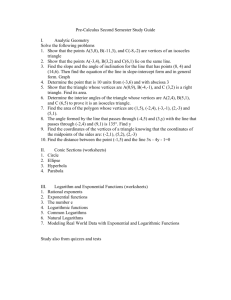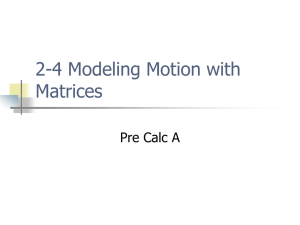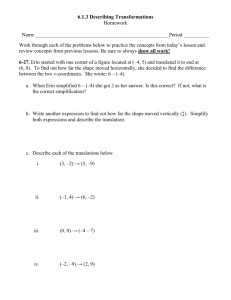1 - National Assessment & Testing
advertisement
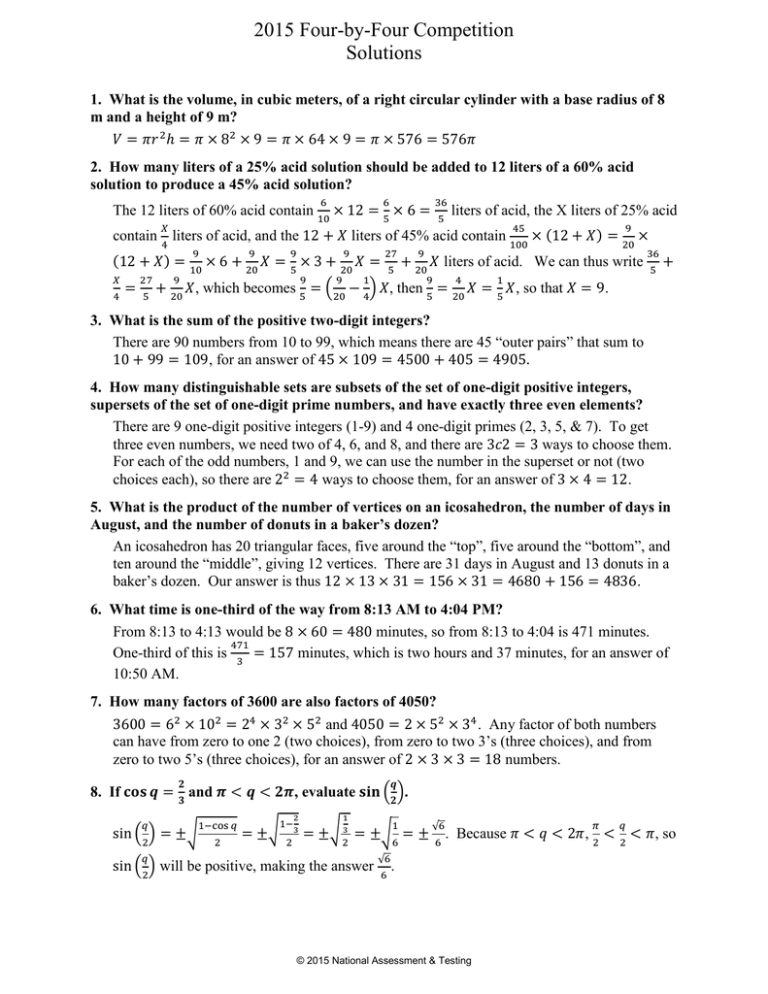
2015 Four-by-Four Competition Solutions 1. What is the volume, in cubic meters, of a right circular cylinder with a base radius of 8 m and a height of 9 m? 𝑉 = 𝜋𝑟 2 ℎ = 𝜋 × 82 × 9 = 𝜋 × 64 × 9 = 𝜋 × 576 = 576𝜋 2. How many liters of a 25% acid solution should be added to 12 liters of a 60% acid solution to produce a 45% acid solution? 6 6 The 12 liters of 60% acid contain 10 × 12 = 5 × 6 = 𝑋 36 5 liters of acid, the X liters of 25% acid 45 9 contain 4 liters of acid, and the 12 + 𝑋 liters of 45% acid contain 100 × (12 + 𝑋) = 20 × (12 + 𝑋) = 𝑋 4 = 27 5 9 9 10 9 9 9 × 6 + 20 𝑋 = 5 × 3 + 20 𝑋 = 9 9 1 27 5 9 + 20 𝑋 liters of acid. We can thus write 9 4 1 36 5 + + 20 𝑋, which becomes 5 = (20 − 4) 𝑋, then 5 = 20 𝑋 = 5 𝑋, so that 𝑋 = 9. 3. What is the sum of the positive two-digit integers? There are 90 numbers from 10 to 99, which means there are 45 “outer pairs” that sum to 10 + 99 = 109, for an answer of 45 × 109 = 4500 + 405 = 4905. 4. How many distinguishable sets are subsets of the set of one-digit positive integers, supersets of the set of one-digit prime numbers, and have exactly three even elements? There are 9 one-digit positive integers (1-9) and 4 one-digit primes (2, 3, 5, & 7). To get three even numbers, we need two of 4, 6, and 8, and there are 3𝑐2 = 3 ways to choose them. For each of the odd numbers, 1 and 9, we can use the number in the superset or not (two choices each), so there are 22 = 4 ways to choose them, for an answer of 3 × 4 = 12. 5. What is the product of the number of vertices on an icosahedron, the number of days in August, and the number of donuts in a baker’s dozen? An icosahedron has 20 triangular faces, five around the “top”, five around the “bottom”, and ten around the “middle”, giving 12 vertices. There are 31 days in August and 13 donuts in a baker’s dozen. Our answer is thus 12 × 13 × 31 = 156 × 31 = 4680 + 156 = 4836. 6. What time is one-third of the way from 8:13 AM to 4:04 PM? From 8:13 to 4:13 would be 8 × 60 = 480 minutes, so from 8:13 to 4:04 is 471 minutes. 471 One-third of this is 3 = 157 minutes, which is two hours and 37 minutes, for an answer of 10:50 AM. 7. How many factors of 3600 are also factors of 4050? 3600 = 62 × 102 = 24 × 32 × 52 and 4050 = 2 × 52 × 34 . Any factor of both numbers can have from zero to one 2 (two choices), from zero to two 3’s (three choices), and from zero to two 5’s (three choices), for an answer of 2 × 3 × 3 = 18 numbers. 𝟐 𝒒 8. If 𝐜𝐨𝐬 𝒒 = 𝟑 and 𝝅 < 𝒒 < 𝟐𝝅, evaluate 𝐬𝐢𝐧 (𝟐). 𝑞 sin (2) = ±√ 1−cos 𝑞 𝑞 2 2 1 1− 1 𝜋 𝑞 √6 = ±√ 2 3 = ±√ 23 = ±√6 = ± 6 . Because 𝜋 < 𝑞 < 2𝜋, 2 < 2 < 𝜋, so sin (2) will be positive, making the answer √6 . 6 © 2015 National Assessment & Testing 2015 Four-by-Four Competition Solutions 9. What is the area, in square meters, of an isosceles triangle with sides measuring 10 m and 30 m? You can’t have a 10-10-30 triangle, so it must be a 30-30-10 triangle. Drawing the altitude, we can turn it into two right triangles with a hypotenuse of 30 and a leg of 5. The Pythagorean Theorem gives the other leg as √302 − 52 = 5√62 − 12 = 5√35, so that the area of the original triangle is 5 × 5√35 = 25√35. 10. Every card in a standard 52-card deck is worth a certain number of points. Each numbered card is worth the number shown on that card. Jacks, Queens, and Kings are worth 10 points each, while Aces are worth 11 points. When a single card is drawn, what is the expected value of the number of points it will be worth? 1 1 Each rank has a 13 chance of being drawn, so the expected value will be 13 (2 + ⋯ + 9 + 1 95 10 + 10 + 10 + 10 + 11) = 13 (30 + 65) = 13. 11. What real value(s) of 𝒑 satisfy 𝟐𝟐𝒑−𝟐 + 𝟐𝒑−𝟐 = 𝟒 + 𝟐𝟑𝒑−𝟔 ? The 𝑝 − 2 and 3𝑝 − 6 might make you think putting everything in terms of 2𝑝−2 might be worthwhile. The equation would then be 4 × (2𝑝−2 )2 + 2𝑝−2 = 4 + (2𝑝−2 )3 , which is a cubic. Substituting 𝑦 = 2𝑝−2 gives 4𝑦 2 + 𝑦 = 4 + 𝑦 3 , which we can write as 𝑦 3 − 4𝑦 2 − 𝑦 + 4 = 0 and factor to (𝑦 − 4)(𝑦 2 − 1) = 0 and then (𝑦 − 4)(𝑦 − 1)(𝑦 + 1) = 0, with roots of 4, 1, and -1. So 2𝑝−2 is 4, 1, or -1, but the last is not possible. If 2𝑝−2 = 4, then 𝑝 = 4, and if 2𝑝−2 = 1, then 𝑝 = 2, for answers of 4 and 2. 12. What is the area of the convex quadrilateral in the Cartesian plane with vertices at (𝟑, 𝟒), (−𝟓, −𝟔), (−𝟕, 𝟖), and (𝟗, −𝟏𝟎)? To use the Shoelace Method, we need to arrange the vertices in order around the quadrilateral, which is (3,4), (−7,8), (−5, −6), (9, −10), and (3,4) again and then crossmultiply (it’s based on the vector cross-product). One set of these products is 3 × 8 + (−7)(−6) + (−5)(−10) + 9 × 4 = 24 + 42 + 50 + 36 = 152, and the other is 4(−7) + 8(−5) + 9(−6) + 3(−10) = −28 − 40 − 54 − 30 = −152. Subtracting these totals and 152−(−152) 304 dividing by two gives = 2 = 152. 2 13. What value(s) of 𝒈 satisfy 𝟗(𝟕𝒈 − 𝟓) + 𝟑𝒈(𝟐 + 𝟒) = 𝟔(𝟖𝒈 + 𝟏)? 51 17 This becomes 63𝑔 − 45 + 18𝑔 = 48𝑔 + 6, then 33𝑔 = 51, giving 𝑔 = 33 = 11. 𝟏𝟒𝝅 14. Convert 𝟐𝟐𝟓 to degrees, minutes, and seconds in the form 𝒅°𝒎′𝒔′′. 14𝜋 225 × 180 𝜋 = 14×180 225 = 14×36 45 = 14×4 5 = 56 5 1 = 11 5 degrees, which is 11°12′ . 15. The number that is 24% less than 620 is 24% greater than what number? 76 100 100 × 620 × 124 = 76×620 124 = 76 × 5 = 380 © 2015 National Assessment & Testing 2015 Four-by-Four Competition Solutions 16. Using the numerals 9, 7, 6, 4, and 1 exactly once each, and the operations of addition, subtraction, multiplication, and division (and parentheses) as much or as little as you like, create an expression that evaluates to 101. There are probably many answers to this, but we focused on products near 101, and quickly focused on 105 = 3 × 5 × 7. We’ve got a 7, and 9 + 6 = 15, so our answer is 7(9 + 6) − 4 × 1. The × 1 could be in several places. 17. If 𝒌 varies jointly as 𝒎 and the square of 𝒏, and 𝒌 = 𝟐𝟒 when 𝒎 = 𝟕 and 𝒏 = 𝟑, then what is the value of k when 𝒎 = 𝟐 and 𝒏 = 𝟔? 2 2 𝑚 was multiplied by 7, so 𝑘 will be multiplied by 7. 𝑛 was multiplied by 2, so 𝑘 will be 2 multiplied by 22 = 4. Thus, the answer is 𝑘 = 24 × 7 × 4 = 48×4 7 = 192 7 . 18. Two circles have radii of 11 m and 17 m and their centers are 40 m apart. What is the length, in meters, of one of their common internal tangents? Drawing the circles, the line segment connecting their centers, the tangent, and the radii to the tangent creates a pair of similar triangles, so that the tangent can be considered the leg of a right triangle with a hypotenuse of 40 and another leg of 11 + 17 = 28. Thus, the tangent’s length will be √402 − 282 = 4√102 − 72 = 4√100 − 49 = 4√51. 19. What is the remainder when 𝒋𝟓 + 𝟔𝒋𝟒 − 𝟏𝟕𝒋𝟑 + 𝟐𝟖𝒋𝟐 − 𝟐𝟑𝒋 + 𝟏𝟓 is divided by 𝒋𝟐 + 𝟖𝒋 − 𝟒? (𝑗 2 + 8𝑗 − 4)(𝑝𝑜𝑙𝑦𝑛𝑜𝑚𝑖𝑎𝑙) + 𝑟𝑒𝑚𝑎𝑖𝑛𝑑𝑒𝑟 = 𝑗 5 + 6𝑗 4 − 17𝑗 3 + 28𝑗 2 − 23𝑗 + 15. The polynomial must start with a 𝑗 3 , contributing 𝑗 5 + 8𝑗 4 − 4𝑗 3 and leaving −2𝑗 4 − 13𝑗 3 + 28𝑗 2 − 23𝑗 + 15. Similarly, the polynomial must contain a −2𝑗 2 leaving 3𝑗 3 + 20𝑗 2 − 23𝑗 + 15, a 3𝑗 leaving −4𝑗 2 − 11𝑗 + 15, and a −4 leaving 21𝑗 − 1. 20. How many distinguishable arrangements of the letters in “BANANAS” do not have any A’s adjacent to other A’s? 4! Consider arranging the B, N, N, and S. There are 2! = 4 × 3 = 12 ways to arrange them. Once they’re arranged, there are five places an A could go (before the first letter, three ways between them, and after the last letter), and the three A’s can choose three of them, which is 5! 5×4 5𝑐3 = 3!×2! = 2 = 10 ways, for an answer of 12 × 10 = 120. 4 8 21. In the figure shown to the right, all given measurements 6 9 are in meters. What is the value of 𝒉, the length of the tangent line segment? The secants from the same point allow us to write ℎ2 = 9 × h (9 + 6 + 8) = 9 × 23, so that ℎ = 3√23. 22. Evaluate: 𝟕 × 𝟖 − (𝟑𝟒 + 𝟔) × 𝟓 + 𝟕𝟔𝟐 − 𝟑𝟓 ÷ 𝟕 + 𝟓𝟔 56 − 200 + 762 − 5 + 56 = −93 + 5776 = 5683 © 2015 National Assessment & Testing 2015 Four-by-Four Competition Solutions 23. If five Cheetahs can be exchanged for three Dogs, four Elephants can be exchanged for seven Foxes, and two Foxes can be exchanged for one Dog, how many Elephants can be exchanged for 6965 Cheetahs? 3 4 6965 × 5 × 2 × 7 = 1393 × 24 7 = 199 × 24 = 4776 24. What is the tenth term of a recursive sequence with first term 𝒂𝟏 = 𝟒𝟖, 𝒂𝟐 = 𝟔𝟒, and 𝒂 +𝒂 𝒂𝒏 = 𝒏−𝟏 𝟐 𝒏−𝟐 for 𝒏 ≥ 𝟑? 𝑎3 = 48+64 2 = 112 2 = 56, 𝑎4 = 64+56 2 = 120 2 = 60, 𝑎5 = 56+60 2 = 116 2 = 58, etc. You may 1 1 1 notice that the differences are 16, -8, 4, -2, …, so our answer will be 58 + 1 − 2 + 4 − 8 + 1 5 11 = 59 − 16 = 58 16 = 16 939 16 . 25. What is the sum of the positive perfect cubes less than 100? 1 + 8 + 27 + 64 = 100 26. What is the total surface area, in square meters, of a right rectangular pyramid with a base measuring 32 m by 18 m and a height of 12 m? The base has an area of 32 × 18 = 320 + 256 = 576. The lateral area is two pairs of congruent triangles, one pair with a base of 32 and the other pair with a base of 18. The heights of these triangles are the slant heights of the pyramid, which are the hypotenuses of right triangles. The height for the 32 base is √92 + 122 = 3√32 + 42 = 3√25 = 3 × 5 = 15, and the height for the 18 base is √162 + 122 = 4√42 + 32 = 4 × 5 = 20, so the lateral surface area will be 18 × 20 + 32 × 15 = 360 + 480 = 840 and the answer is 840 + 576 = 1416. 27. Simplify in terms of 𝒊 = √−𝟏: (𝟏 − 𝟑𝒊)𝟓 (1 − 3𝑖)5 = (1 − 3𝑖)2 (1 − 3𝑖)2 (1 − 3𝑖) = (−8 − 6𝑖)(−8 − 6𝑖)(1 − 3𝑖) = (28 + 96𝑖)(1 − 3𝑖) = 316 + 12𝑖 28. How many positive three-digit integers are multiples of three with their digits in strictly ascending order? To be a multiple of 3, the digits must add up to a multiple of 3, so the digits could be 129, 126, 123, 138, 135, 147, 159, 156, 168, 189, 237, 234, 249, 246, 258, 267, 279, 348, 345, 357, 369, 378, 459, 456, 468, 489, 567, 579, 678, and 789. Each of these can only be arranged one way, because the digits must be in strictly increasing order, so the answer is 30. 𝟑 29. Express in simplest radical form: √𝟏𝟐𝟗𝟔𝟎 3 3 3 3 √12960 = √64 × 10 = 6 √6 × 10 = 6 √60 30. Expand and combine like terms: (𝒃 − 𝟐)(𝟑𝒃𝟐 − 𝟕𝒃 + 𝟏𝟐)(𝟐𝒃 + 𝟒) (3𝑏 2 − 7𝑏 + 12)(2𝑏 2 − 8) = 6𝑏 4 − 14𝑏 3 + 56𝑏 − 96 © 2015 National Assessment & Testing 2015 Four-by-Four Competition Solutions 31. A square has vertices (𝟎, 𝟎), (𝟗, 𝟔), (𝒂, 𝒃), and (𝒄, 𝒅), where (𝒄, 𝒅) is in the second quadrant. Find 𝒂 + 𝒃 + 𝒄 + 𝒅. The known line segment could be a side or a diagonal of the square. If it were a diagonal, there wouldn’t be any vertices in the second quadrant, so the known line segment must be a side of the square. The rest of the square could be down and to the right, but in that case there would again be no vertices in the second quadrant. So, the square is nine units up and six to the left, so one of the vertices will be (−6,9) and the other will be (3,15), for an answer of −6 + 9 + 3 + 15 = 21. 32. Hannah will arrive at the arcade between noon and 1 PM, stay for 20 minutes, and leave. Phaedra will arrive at the arcade between 11 AM and 12:30, stay for 45 minutes, and leave. What is the probability that Hannah and Phaedra will be at the arcade at the same time? The entire event space can be represented by a rectangle with Phaedra’s arrival times across the bottom and Hannah’s up the side, so that it has an area of 90 × 60. If Phaedra arrives at 11:15, Hannah could just catch her at noon. This relationship continues for the next 60 minutes, forming a line up and to the right through the rectangle until Phaedra arrives at 12:15 and Hannah barely catches her at 1:00. The trapezoid to the left of this line represents situations in which Phaedra arrives and leaves before Hannah shows up. Similarly, if Hannah arrives at noon, Phaedra could just catch her at 12:20, and this continues until 12:10 and 12:30, with the triangle to the right of this representing situations where Hannah arrives and leaves before Phaedra shows up. Thus, the probability that they meet is 5400− 15+75 10×10 ×60− 2 2 5400 = 5400−45×60−50 5400 = 540−45×6−5 540 = 108−9×6−1 108 = 108−54−1 108 53 = 108. 33. Consider a triangle with sides measuring 8 m, 12 m, and 15 m. If the angle bisector of the largest angle is drawn, what is the length, in meters, of the smaller segment into which it divides the opposite side of the triangle? 8 8 2 The smaller segment will be 8+12 × 15 = 20 × 15 = 5 × 15 = 2 × 3 = 6. 34. Express the base-8 numeral 𝟐𝟑𝟔𝟕𝟓𝟖 as a base-4 numeral. In base 8, every pair of digits can take on 8 × 8 = 64 values, and in base 4 every trio of values can take on 4 × 4 × 4 = 64 values. 758 = 61, which is 3314 , 368 = 30, which is 1324 , 28 = 2, which is 24 , for an answer of 21323314 . 35. Evaluate: 𝟗𝟑𝟓𝟔𝟕𝟕𝟒 ÷ 𝟓𝟕𝟒 The standard algorithm gives 16301. 36. I won the lottery! Being frugal, I simply took the million dollars and put it in an account earning 2% annual interest, compounded annually. After five years, how much will be in my account? Answer to the nearest hundredth of a dollar (cent). The first year, I earn 20,000 to have 1,020,000.00. The second year I end up with 1,040,400.00, then 1,061,208.00 in the third year. The fourth year I earn 21,224.16 for a total of 1,082,432.16, and the fifth year I earn 21,648.6432 for a final total of 1,104,080.8032, which round to our answer of $1,104,080.80. © 2015 National Assessment & Testing 2015 Four-by-Four Competition Solutions 37. What is the shortest distance from the point (𝟏, −𝟐) to the line 𝟑𝒙 − 𝟒𝒚 = 𝟓? Writing the line as 3𝑥 − 4𝑦 − 5 = 0, we can use the formula |3(1)−4(−2)−5| √32 +42 = |3+8−5| 5 6 = 5. 38. When four standard dice are rolled, what is the probability that at most one of the dice does not show the same number as another die? The “good” results are AAAA (6 ways), AAAB (6 × 5 × 4 = 120 ways), and AABB (6𝑐2 × 216 1 4𝑐2 = 15 × 6 = 90 ways), for a total of 216 ways and a probability of 64 = 6. 39. Consider a circle inscribed in a square. A 3 m by 5 m rectangle is drawn outside the circle but inside the square such that one of its vertices is a vertex of the square, another of its vertices is on the circle, and two of its sides are on the square. What is the radius, in meters, of the circle? Drawing the square, circle, and rectangle, you can draw a right triangle inside the circle, giving (𝑟 − 5)2 + (𝑟 − 3)2 = 𝑟 2 , which becomes 𝑟 2 − 10𝑟 + 25 + 𝑟 2 − 6𝑟 + 9 = 𝑟 2, then 𝑟 2 − 16𝑟 + 34 = 0. The quadratic formula gives 𝑟 = 16±√162 −4×34 2 = 8 ± √82 − 34 = 8 ± √30. 8 − √30 is less than 5 and 3, so is not a possible answer, so that our answer is 8 + √30. 40. When Mr. Brown asks students to find the roots of a quadratic of the form 𝑨𝒙𝟐 + 𝑩𝒙 + 𝑪 = 𝟎, Sam miscopies the value of 𝑨 and gets roots of 2 and 3, and Anthea miscopies the value of C and gets roots of -1 and 4. What are the actual roots of Mr. Brown’s equation? Sam must have thought the quadratic was a multiple of (𝑥 − 2)(𝑥 − 3) = 𝑥 2 − 5𝑥 + 6 = 0, while Anthea must have thought it was a multiple of (𝑥 + 1)(𝑥 − 4) = 𝑥 2 − 3𝑥 − 4 = 0. Because they were both right about the value of B, their quadratics must have been 3𝑥 2 − 15𝑥 + 18 = 0 and 5𝑥 2 − 15𝑥 − 20 = 0, so that the original quadratic must have been 5𝑥 2 − 15𝑥 + 18 = 0. The quadratic equation gives 𝑥 = 15±√−135 10 = 15±√152 −4×5×18 15±3𝑖√15 10 . © 2015 National Assessment & Testing 2×5 = 15±√225−360 10 =
